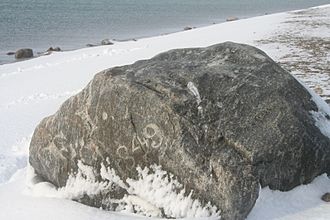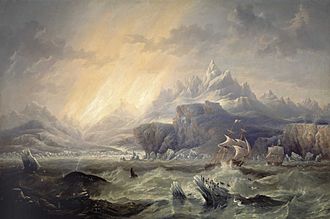James Clark Ross facts for kids
Quick facts for kids
Sir
James Clark Ross
|
|
|---|---|
 |
|
| Born | 15 April 1800 Finsbury Square, London. England, United Kingdom |
| Died | 3 April 1862 (aged 61) Aylesbury, Buckinghamshire, England, United Kingdom |
| Buried |
St James, Aston Abbotts
|
| Branch | |
| Service years | 1812–1862 |
| Rank | Captain |
| Expeditions | Ross expedition (1839–1843) |
| Awards |
|
| Spouse(s) |
Ann Coulman (m. 1843)
|
| Relations | Sir John Ross (uncle) |
Sir James Clark Ross (born April 15, 1800 – died April 3, 1862) was a brave naval officer and explorer from England. He is famous for exploring both the cold Arctic and the icy Antarctica. He sailed with his uncle, Sir John Ross, and Sir William Parry in the Arctic. Later, he led his own important journey to Antarctica. James Clark Ross was born in London, England, and passed away in Aylesbury, England.
Contents
Amazing Journeys of James Clark Ross
Exploring the Arctic
James Clark Ross was born in London. He joined the Royal Navy in 1812, when he was just 12 years old! His uncle, Sir John Ross, was also a naval officer. James went with his uncle on his first Arctic trip in 1818. They were looking for the Northwest Passage, a sea route through the Arctic.
Between 1819 and 1827, James joined four more Arctic trips. These were led by Sir William Parry. From 1829 to 1833, he sailed with his uncle Sir John Ross again. On this journey, James Ross and his team made a huge discovery. On June 1, 1831, they found the exact spot of the North Magnetic Pole. This is the point on Earth where a compass needle points straight down. They found it on the Boothia Peninsula in northern Canada. During this trip, Ross also mapped some islands. His uncle later named them Clarence Islands.
In 1834, James Ross became a captain. In 1835, he helped rescue 11 whaling ships stuck in the ice in Baffin Bay. He sailed in a ship called HMS Cove. The journey was tough, but most whaling ships had already freed themselves. He found no sign of the last ship, which was likely crushed by ice. Ross returned safely in September 1836.
From 1835 to 1839, Ross also helped map the magnetic field of Great Britain. He worked with Sir Edward Sabine on this project.
Discovering Antarctica
From 1839 to 1843, James Clark Ross led his own expedition to Antarctica. He commanded a ship called HMS Erebus. Captain Francis Crozier was his second-in-command, leading HMS Terror. These ships were special. They were called bomb vessels and had very strong hulls. This design helped them survive the thick ice of Antarctica.
In 1841, James Ross made amazing discoveries. He found the Ross Sea, a large bay in Antarctica. He also found Victoria Land, a part of the continent. Most excitingly, he discovered two volcanoes: Mount Erebus and Mount Terror. He named them after his expedition's ships.
They sailed along a huge, flat wall of ice. They called it the Barrier or the Great Ice Barrier. This massive ice shelf was later named the Ross Ice Shelf in his honor. The next year, he tried to go even further south. He explored the eastern side of what is now James Ross Island. He also found and named Snow Hill Island and Seymour Island.
Ross's ships returned to England on September 4, 1843. For his incredible work, he received the Grande Médaille d'Or des Explorations award in 1843. He was made a knight in 1844, becoming "Sir" James Clark Ross. In 1848, he was chosen to join the Royal Society, a famous group of scientists.
Searching for Franklin's Lost Expedition

In 1848, Sir James Clark Ross was sent on a new mission. He was part of a search for Sir John Franklin and his lost Arctic expedition. Ross commanded HMS Enterprise, with HMS Investigator joining him.
Heavy ice in Baffin Bay made their journey difficult. They only reached the northeast tip of Somerset Island. There, their ships got stuck in the ice for the winter. In the spring, Ross and Francis McClintock explored the island's west coast by sledge. Ross saw Peel Sound but thought it was too full of ice for Franklin's ships to have used it. However, Franklin had actually sailed through it in 1846 when there was less ice. The next summer, Ross tried to reach Wellington Channel but was again blocked by ice. He then returned to England.
Personal Life
Sir James Clark Ross was married to Lady Ann Coulman. He passed away in Aylesbury in 1862, five years after his wife. His home in Blackheath, London, has a special blue plaque to remember him. His closest friend was Francis Crozier, who sailed with him on many journeys.
He also lived in a historic house in Buckinghamshire. He and his wife are buried in the local churchyard of St. James the Great, Aston Abbotts. In the gardens of his home, there is a lake with two islands. These islands are named Terror and Erebus, after his famous Antarctic ships.
In Stories
James Clark Ross appears as a character in some stories. He is in the 2018 AMC TV show The Terror and the 2007 novel it's based on. These stories show a fictional version of his search for Franklin's lost expedition. He is also mentioned often in Jules Verne's novel The Adventures of Captain Hatteras.
Tributes to James Clark Ross
Many places and animals are named after Sir James Clark Ross to honor his discoveries:
- The Ross seal, an Antarctic seal, was first described during his expedition.
- The James Ross Strait, Ross Bay, Ross Point, and Rossoya in the Arctic are all named after him.
- The RRS James Clark Ross is a research ship used by the British Antarctic Survey.
- The crater Ross on the Moon is named after him.
- Ross's gull, a small bird that lives in the Arctic, is named after him.
- In Antarctica, the Ross Dependency, Ross Island, Ross Ice Shelf, and Ross Sea are all named in his honor.
- Mont Ross, the highest mountain in the Kerguelen Islands, is also named after him.
Images for kids
-
An illustration of James Clark Ross discovering the North Magnetic Pole.
See also
 In Spanish: James Clark Ross para niños
In Spanish: James Clark Ross para niños




